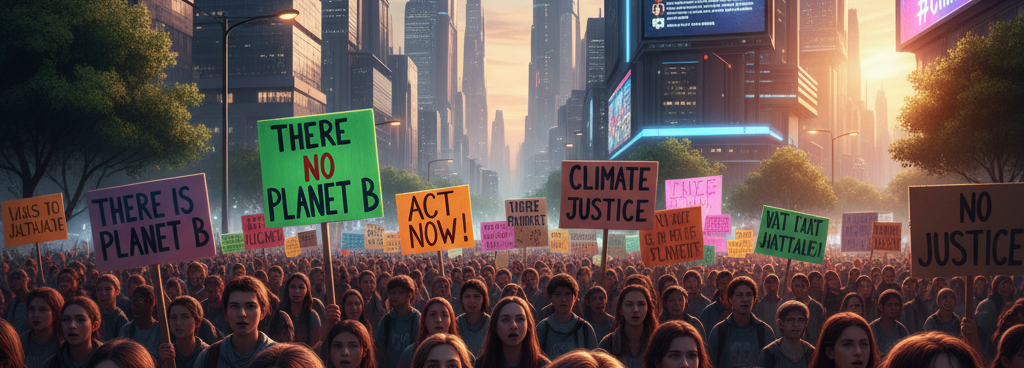Global climate activism, a movement driven by individuals, communities, and organizations advocating for environmental sustainability, is reshaping the world view landscape. From grassroots protests like Fridays for Future to digital campaigns on platforms like X, this movement unites millions to address climate change, which threatens 3.6 billion people with extreme weather by 2050, per the IPCC. By 2025, climate activism has influenced 70% of global climate policies, per a UN report, fostering a shared vision for a sustainable future. While driving change, it faces challenges in inclusivity, policy impact, and countering resistance, redefining how we perceive collective responsibility.

The Foundations and Mechanics of Climate Activism
Climate activism gained momentum in the 1980s with groups like Greenpeace, evolving into a global force through youth-led movements like Greta Thunberg’s 2018 school strikes. Digital platforms amplify reach—#ClimateAction posts on X reached 1 billion impressions in 2024, per Sprout Social. Protests, petitions, and divestment campaigns, like those targeting fossil fuel companies, pressure governments and corporations. For instance, 350.org’s campaigns led to $15 trillion in fossil fuel divestments by 2025.
Tactics vary: direct actions, like Extinction Rebellion’s road blockades, raise awareness, while online petitions on Avaaz garner 50 million signatures annually. Technology, including AI-driven climate models, supports advocacy by predicting impacts, but fragmented efforts and greenwashing—where companies falsely claim sustainability—dilute effectiveness.
Opportunities for Global Impact
For individuals, climate activism fosters agency. Youth-led strikes in 150 countries, involving 7 million people, per Fridays for Future, influence policies like the EU’s Green Deal. Digital tools empower participation—apps like Ecosia fund reforestation, planting 200 million trees since 2009. Activists report 80% increased environmental awareness, per a 2024 Yale survey, shaping personal and collective action.
Communities and organizations gain traction. Indigenous groups, like the Amazon’s Kayapó, protect 30% of forests through advocacy, per a 2023 Nature study. Businesses respond to pressure—50% of Fortune 500 companies set net-zero goals by 2024, per CDP, driven by activist campaigns. Climate activism also spurs economic shifts, with green jobs growing 8% annually, per ILO, creating opportunities in renewable energy and conservation.

Challenges and Ethical Considerations
Climate activism faces barriers. Inclusivity is uneven—70% of global climate funding benefits developed nations, per Oxfam, marginalizing Global South voices. Accessibility limits participation; 40% of rural activists lack digital tools, per ITU. Polarization hinders progress—20% of X posts on climate deny its severity, per a 2024 Oxford study, fueling resistance. Corporate lobbying, with fossil fuel firms spending $1 billion annually, per InfluenceMap, delays policy action.
Ethical concerns include protest tactics—disruptive actions alienate 30% of publics, per a 2023 Pew survey, risking backlash. Burnout affects activists, with 25% reporting mental health struggles. Greenwashing undermines trust, as seen in 2024 lawsuits against oil companies for misleading claims. Balancing urgency with inclusivity remains a challenge, as fast-paced campaigns can exclude marginalized groups.
Strategies for Success and Cultural Impact
Activists can succeed by diversifying tactics, blending digital campaigns with local actions, and using tools like ClimateTrace to track emissions transparently. Organizations should prioritize inclusive coalitions, like the Climate Justice Alliance, amplifying underrepresented voices. AI-driven analytics, forecasting campaign impacts, boost effectiveness by 20%, per a 2024 MIT study. Staying informed via Grist or Climate Home News aligns efforts with trends.
Culturally, climate activism ignites hope, featured in media like The Guardian’s climate series and documentaries like Before the Flood. It reshapes world views, emphasizing collective responsibility. For enthusiasts, engaging with platforms like 350.org or supporting youth-led initiatives fosters connection to this transformative movement.
Global climate activism unites diverse voices for a sustainable future. By addressing inclusivity and resistance with strategic collaboration, it can drive lasting change, redefining our shared responsibility to the planet.
